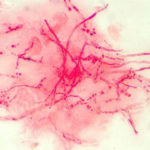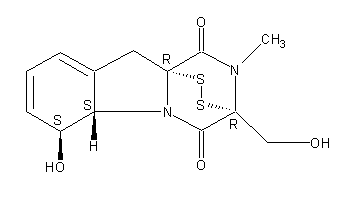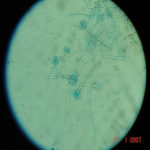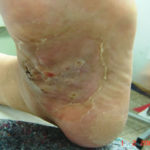Date: 26 November 2013
Secondary metabolites, structure diagram: Trivial name – gliotoxin
Copyright: n/a
Notes:
Species: A. flavus, A. fumigatus, A. niger, A. terreus, Eurotium chevalieri, Neosartorya pseudofischeriSystematic name: 10H-3,10a-Epidithiopyrazino[1,2-a]indole-1,4-dione, 2,3,5a,6-tetrahydro-6-hydroxy-3-(hydroxymethyl)-2-methyl-, (3R,5aS,6S,10aR)-Molecular formulae: C13H14N2O4S2Molecular weight: 326.393Chemical abstracts number: 67-99-2Selected references: Larsen TO, Smedsgaard J, Nielsen KF, Hansen MA, Samson RA, Frisvad JC. Production of mycotoxins by Aspergillus lentulus and other medically important and closely related species in section Fumigati. Med Mycol. 2007 May;45(3):225-32. Belkacemi, L.; Barton, R. C.; Hopwood, V.; Evans, E. G. V. (CORPORATE SOURCE PHLS Mycology Reference Laboratory, Department of Microbiology, University of Leeds, Leeds, UK). SOURCE Med. Mycol., 37(4), 227-233 (English) 1999 Blackwell Science Ltd. Lewis RE, Wiederhold NP, Lionakis MS, Prince RA, Kontoyiannis DP.J Clin Microbiol. 2005 Dec;43(12):6120-2. Frequency and species distribution of gliotoxin-producing Aspergillus isolates recovered from patients at a tertiary-care cancer center.Toxicity: Gliotoxin posseses a spectrum of biological activities including antibacterial and antiviral activities, and it is also a potent immunomodulating agent. Gliotoxin is also an inducer of apoptotic cell death in a number of cell types, and it has been found to be associated with some diseases attributed directly or indirectly to fungal infections. It is a secondary metabolite produced by a number of Aspergillus and Penicillium species.It is a potent immunosuppressive metabolite and brings about apoptosis in cells. Because of its effects on the immune system it may have a place in transplant surgery. There is limited evidence for its occurrence in moulded cereals. A. fumigatus is a potent pathogen which can colonise the lungs and other body tissues after ingestion of spores. There is some limited evidence that gliotoxin may be formed in situ in such circumstances. hamster LDLo oral 25mg/kg (25mg/kg) Veterinary and Human Toxicology. Vol. 32(Suppl), Pg. 63, 1990.mouse LD50 intraperitoneal 32mg/kg (32mg/kg) Chemotherapia. Vol. 10, Pg. 12, 1965. mouse LD50 intravenous 7800ug/kg (7.8mg/kg) Chemotherapia. Vol. 10, Pg. 12, 1965. mouse LD50 oral 67mg/kg (67mg/kg) Chemotherapia. Vol. 10, Pg. 12, 1965. mouse LD50 subcutaneous 25mg/kg (25mg/kg) Chemotherapia. Vol. 10, Pg. 12, 1965. rabbit LDLo intravenous 45mg/kg (45mg/kg) VASCULAR: BP LOWERING NOT CHARACTERIZED IN AUTONOMIC SECTION. GASTROINTESTINAL: HYPERMOTILITY, DIARRHEA Journal of the American Chemical Society. Vol. 65, Pg. 2005, 1943. rat LDLo intravenous 45mg/kg (45mg/kg) Veterinary and Human Toxicology. Vol. 32(Suppl), Pg. 63, 1990.rat LDLo unreported 50mg/kg (50mg/kg) BEHAVIORAL: ALTERED SLEEP TIME (INCLUDING CHANGE IN RIGHTING REFLEX) Journal of the American Chemical Society. Vol. 65, Pg. 2005, 1943.
Images library
-
Title
Legend
-
Bilateral A. fumigatus endophthalmitis in association with pulmonary and cerebral aspergillosis, complicating severe autoimmune disease treated with intense immunosuppression. Left eye.
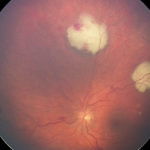
-
Aspergillus keratitis – a case of fungal keratitis following amnoiotic membrane transplantation (AMT) for bullous keratopathy. Slit-lamp photograph of left eye showing ring shaped stromal infiltrate.
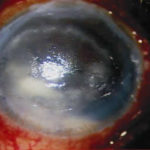
-
A 14 year old boy with a T cell lymphoma received induction chemotherapy with high dose dexamethasone. At no time during this therapy was he neutropenic. Three weeks into treatment his dexamethasone was reduced and stopped due to gastro-intestinal side effects. On recovery of his abdominal symptoms, he developed sudden onset of severe right sided pleuritic chest pain. Initially, he was thought to have a pulmonary embolism as a chest X-ray showed a solid wedge shaped area of consolidation. He then developed a cough and temperature and sputum grew Aspergillus fumigatus. The wedge shaped lesion developed cavitation. Despite AmBisome at 5mg/Kg, commenced within 4 days of onset of symptoms, the chest X-ray appearance got gradually worse over the following week. This led to substitution of Ambisome by caspofungin and voriconazole. He developed a thyroid cyst with haemorrhage that on aspiration grew A. fumigatus. His chest X-ray continued to worsen. He underwent a right lower lobe lobectomy, which confirmed the diagnosis of invasive pulmonary aspergillosis. Unfortunately the thyroid cyst continued to increase in size resulting in removal of the right lobe of the thyroid.
Chest CT scan carried out 3 weeks after lobectomy revealed new lesions within the right upper lobe of the lung. At this time the voriconazole therapy was stopped and posaconazole started. The area of the thyroid remains free of Aspergillus and the lung lesions appear to be improving 6 weeks after the start of posaconazole.
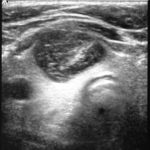 ,
,  ,
, 
-
Aspergillus keratitis. Severe peripheral lesion due to aspergillus unlikely to respond well to treatment.

-
Aspergillus keratitis. Corneal scar at end of treatment of case in previous slide.Vision recovered to 6/9.

-
Aspergillus keratitis. Severe central aspergillus infection with a “cheesey†looking area of the lesion and hypopyon (fluid level of inflammatory cells in the anterior chamber)

-
Corneal ulcer – gram stain. Corneal scrapings were taken from a 67 yr old farmer presenting with a corneal ulcer of the right eye. A piece of vegetable matter was embedded in the cornea and scrapings were done. Gram stain (500x magnification) showed numerous septate hyphae. Cultures grew a small amount of A fumigatus.
